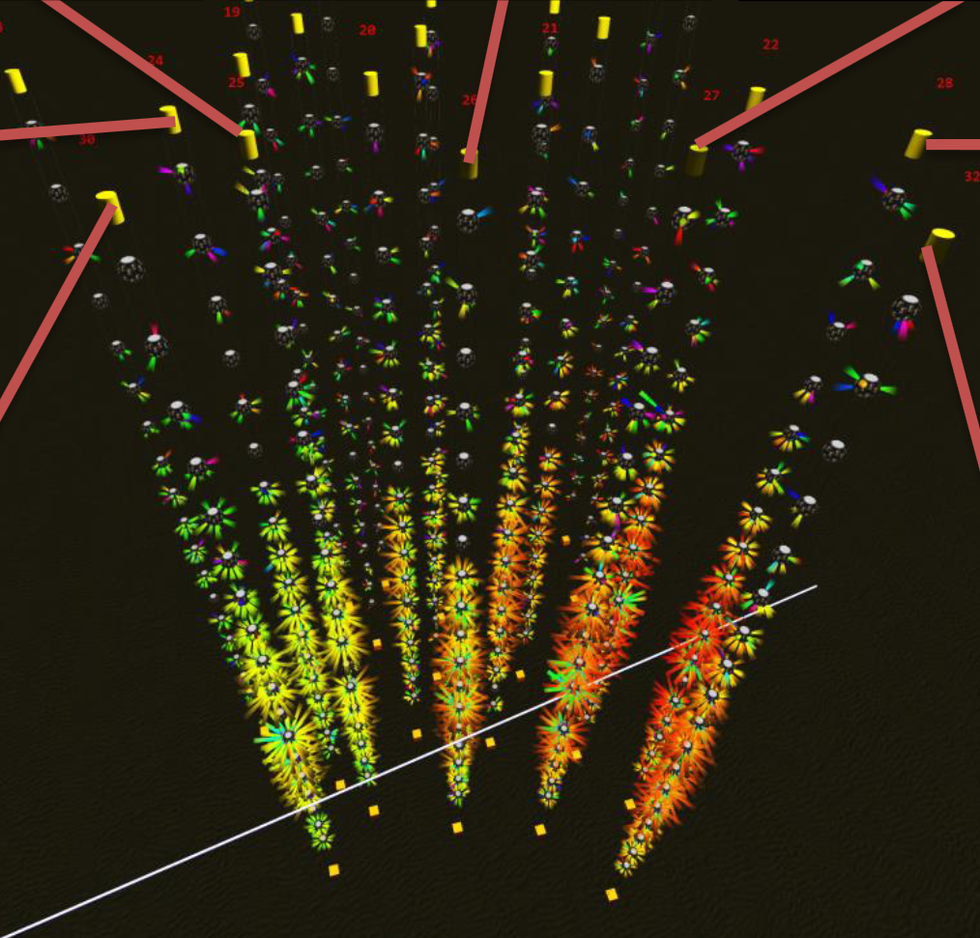 |
| oxygen//Getty Images |
Deep-sea sensors detected the most energetic neutrino ever recorded.
A new neutrino sensor array, ARCA, lines the Mediterranean
seafloor near Sicily.
A physicist took ARCA’s first huge win to a warm
audience at the Neutrino 2024 conference.
The highly energetic neutrino could indicate a source
from an explosion in the cosmos.
At a conference in June, physicist Joao A. B. Coelho of the French Astroparticle and Cosmology Laboratory presented a project that shares a fair amount of DNA wit Twister’s Dorothy: a big group of spherical artificial eyeballs that may help us detect featherlight neutrino particles from under the ocean. These ‘eyeballs’ are encased in a sphere, and then those spheres are in turn encased in another sphere. Could a massive installation on the seafloor off the coast of Sicily help us pinpoint more of the universe’s mysterious (but plentiful) neutrinos?
Building facilities or infrastructure under the deep
sea is a huge challenge. At about 3,500 meters (around 11,500 feet) deep in the
Mediterranean Sea, the ARCA portion of the KM3NeT research rig experiences
about 348 atmospheres of pressure. Compared with the one atmosphere of pressure
we experience at sea level, and you can get an idea of the intensity of the
conditions that far down. Deep underwater, however, sensors have a better
chance of observing neutrinos because they are shielded from some of the electromagnetic
noise of the surface.
These clusters of sensors—which are hooked onto
vertical strands that are 700 meters (about 2,200 feet) long—detect and
separate three distinct layers of particle noise. Layer one is the naturally
occurring background “optical noise,” which Coelho explained is mostly from the
decay of the radioactive isotope potassium 40. This noise is so steady that it
can actually help to calibrate the instruments, and it may also reveal
neutrinos ejected from supernovae (which have a different signature than others
detected by this machinery).
Layer two of the noise is cosmic rays from outer space. They constantly strike Earth’s atmosphere, and they become fireworks of particles when they collide with the nuclei of atoms found there. These resulting particles, Coelho explained, are muons that rapidly decay, making optical noise that can also be used for calibration, as well as helping to solve some outstanding problems with the existence of muons.
Finally, layer three is where we get neutrinos coming from Earth’s atmosphere. Some of the cosmic rays that strike our atmosphere create muons that, in turn, decay into muon neutrinos. In a strange way, it’s like an avocado that arrives from space. When the ‘avocado’ (cosmic ray) strikes a nucleus, it loses its ‘skin,’ leaving a less stable ‘flesh’ (muon) beneath. Then that flesh is stripped by physics, leaving only the ‘seed’ (muon neutrino). What we want here is that neutrino.
Neutrinos are so extremely tiny that they can pass easily through almost anything, including water and the Earth itself. “The Earth is a great cosmic ray shield, but neutrinos don’t care,” Coelho explained on a slide. So, the strands of sensors on the deep-sea ARCA setup can detect these tiniest particles, as well as information that gives us what “flavor” the neutrinos are.
 |
| Joao A.B. Coelho |
At the conference, Coelho was coy about an upcoming piece of news from ARCA and KM3NeT. Nature reports that ARCA has already detected the likely most energetic neutrino to date, and unlike the chill neutrinos created in our atmosphere, this one is probably from something “cataclysmic” in the faraway cosmos. And this is ARCA’s secret weapon: a fourth layer that ignores all the previous noise in order to amplify energetic neutrinos from further away.
At this energy level, Coelho explained, it’s almost always very dark. When many of ARCA’s sensors lit up with an unexpected and very bright event, the scientists all took notice. The energetic neutrino signature seems to have given ARCA a proving ground to continue searching for neutrinos from the cosmos—as well as their explosive sources.




0 Comments